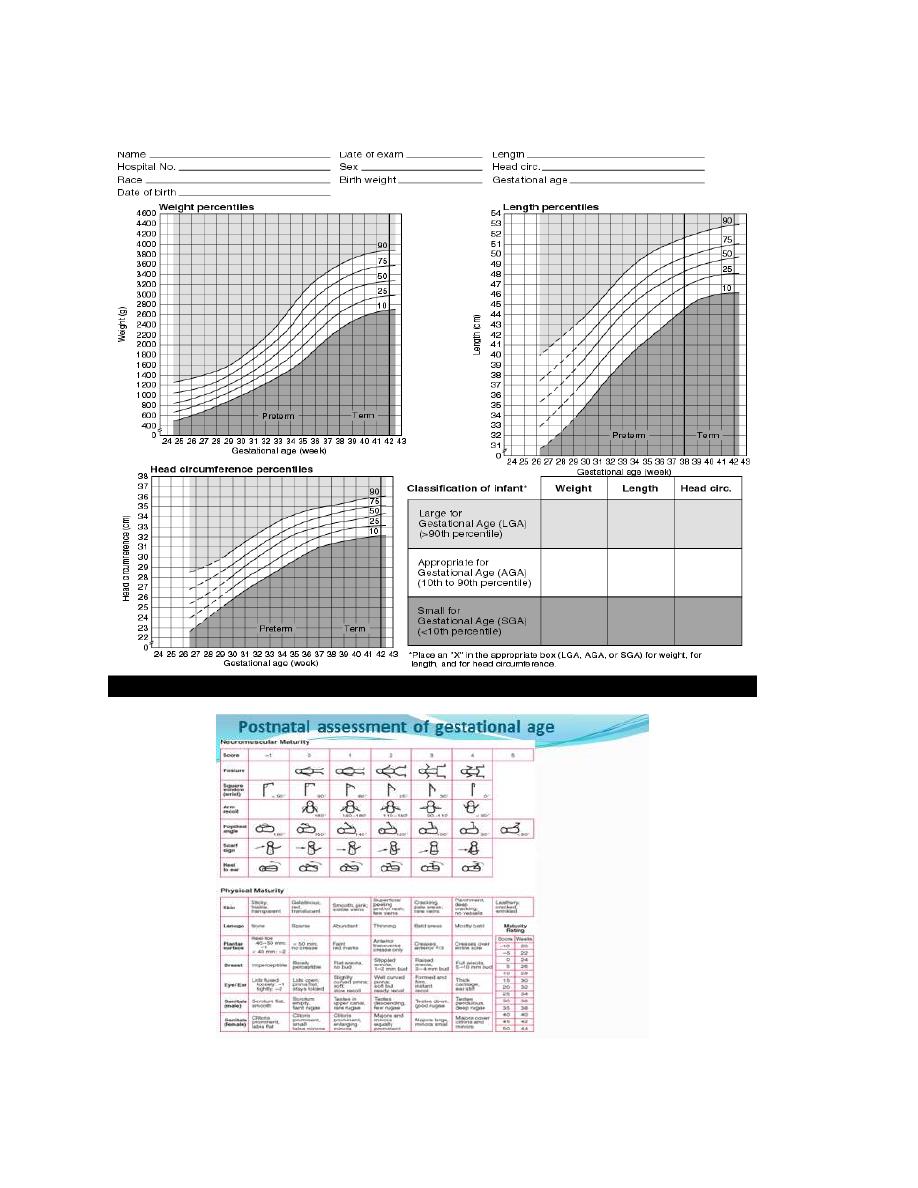
1
Professor Numan Nafie Hameed
ا.د نعمان نافع
الحمداني
NEWNORN BABIES (NB)
A pregnant woman in her first trimester came for regular antenatal care visit. One of the
followings cannot be used by the obstetrician during this visit to assess the gestational age:
a. Date of last menstrual period
b. Expected delivery date
c. quickening (Date of first reported fetal activity and movement)
d. First reported fetal heart sounds
e. Abdominal Ultrasound examination
A 750-g female experienced respiratory distress after a preterm delivery at 27 weeks’
gestation. Pregnancy was uncomplicated, but labor was abrupt and therefore the mother
did not receive steroid or penicillin therapy. The baby required intubation and Mechanical
Ventilation with 100% O
2
. The possible causes of respiratory distress include all the
following except:
a. Spontaneous Pneumothorax
b. Transient tachypnea of newborn
c. Lobar emphysema
d. Group B streptococcal infection
e. Respiratory distress syndrome
Neonatal period: It is the first 4 weeks of human life (28 days). It is divided into:
Early
Neonatal period: is the first week of life (7 days)
Late
Neonatal period: > 7- 28 days of life
Perinatal mortality rate (PMR): Is the number of still born babies after 20 weeks
of gestation + number of deaths in the first week of life per 1000 total births.
Neonatal mortality rate (NMR): Is the number of infants died during the first 28
days of life per 1000 live births.
NB by gestational age is classified as
PRETERM: NB delivered before 37 completed weeks (<259 days).

2
FULL TERM: NB delivered between 37-42 weeks (260- 294 days).
POST TERM: NB delivered after 42 weeks (>295 days).
NB gestational age is assessed by:
1. History: LMP & EDD and quickening (Date of first reported fetal activity,
usually occurs at 16-18 weeks)
2. Examination: Fundal height by obstetrician Examination and Expanded
new Ballard score by Pediatrician
3. Investigations: First reported fetal heart sounds (10-12 weeks by Doppler
ultrasound examination) and Ultrasound examination (very accurate if
obtained before 20 weeks' of gestation).
NB by birth weight on growth charts is classified as:
Small for gestational age (SGA) Is NB with birth weight of < 10 th centile
Appropriate for age (AGA) Is NB with birth weight between 10
th
-90
th
centiles
Large for gestational age (LGA) Is NB with birth weight of > 90 th centile
Full term neonates normally have the following:
BW: Average 3.250 g (7.5 pounds), 95 % (2.500 – 4.250 g)
Length: 50 cm, 95 % (46 – 56 cm)
OFC 35 cm, 95 % (33 – 38 cm)
Hb 14 – 22 g/ dl
WBC 5000 - 20000 / cm
3
BP 80/50 mm Hg
RR 40 – 60 breaths/ minutes
PR 120 – 160 beats / minutes

3
Urine passed within 24 hours of birth, max. 40 hours
Meconium passed within 24 hours, max 48 hours, If > 48 hours, think of
imperforated anus. Preterm neonates might normally have delayed passage of
meconium longer than 48 hours.
LOW BIRTH WEIGHT NEONATES (LBWN):
They are neonates whose birth weight < 2500 grams. They represents 6-7 % of
all births, but they accounts for 2/3 of all neonatal deaths.
LBWN could be preterm, SGA, or both
PRETERM NEONATES: Any neonate who was born before 37 weeks completed.
Causes:
1. Maternal causes: maternal age <16 - >35 years, grand parity, smoking,
poor housing, short stature, alcohol consumption, chronic maternal
diseases like chronic HT, cyanotic CHD, chronic renal diseases, acute
infections during pregnancy and drug abuse like cocaine.
2. Placental causes: placenta previa, abruption of placenta.
3. Uterine causes: Bicornuate uterus, cervical incompetence.
4. Fetal causes: Fetal distress, multiple gestations, erythroblastosis fetalis,
congenital anomalies, and non-immune hydropis fetalis.
5. Others: Premature rupture of membranes, polyhydraminos, iatrogenic
e.g. poorly timed C/S, trauma including surgery.
PROBLEMS OR DISADVANTAGES OR COMPLICATIONS OF PREMATURITY:
1. Birth asphyxia and the need for resuscitation at birth (perinatal
depression): due to immaturity of respiratory Centre, thin flail chest wall,
and deficiency of surfactant.

4
2. Thermal instability (hypothermia or hyperthermia): Hypothermia may be
due to large S.A compared to BWT, little or no subcutaneous fat, poor
muscular activity, poor sweating mechanism, immature heat regulating
centre in brain. So protect preterm neonates by putting him under over
head heater after delivery and then in incubator.
3. Weak cough, sulking, swallowing and coordination reflexes: so they are
prone to aspiration pneumonia if given direct fed before 34 weeks.
4. Respiratory problems: RDS, pneumothorax, apnea and bradycardia,
congenital pneumonia and later BPD.
5. Jaundice and liver immaturity: jaundice may be severe leading to
kernicterus. Liver immaturity may lead to bleeding, hypoproteinemia--
edema.
6. Metabolic: hyper or hypoglycemia, hypocalcaemia, electrolyte
disturbances, osteopenia of prematurity, and acidosis, low thyroxin
status.
7. CVS: Hypotension due hypovolemia, cardiac dysfunction and
vasodilatation due to sepsis. PDA leading to heart failure especially if
associated with RDS.
8. CNS: Perinatal CNS depression, increase incidence of IVH, perventricular
leukomalacia, seizures, deafness and hypotonia.
9. GIT: intolerance to formula feed especially fat, Paralytic ileus,
hyperbilirubinemia
,
NEC, while breast feeding is protective against NEC.
10. Increase susceptibility to infections: due to very low immunoglobulin
levels and impaired cell mediated immunity.
11. Hematologic: Anemia which may be exaggerated by frequent blood
samplings. It may be early in the first 2 weeks and late after 6 weeks.

5
12. Ophthalmologic: Retinopathy of prematurity (ROP) which may lead to
Partial or total blindness especially if received high 02 concentration for
long period. They require follow up by fundoscopic examinations.
13. Surgical problems: especially inguinal hernia which can be dangerous as it
might strangulate at any time so operate as early as possible.
14. Renal problems: hypernatremia, hyponatremia, hyperkalemia, edema
Decreased GFR, inability to handle water and solute overload. Fluid and
electrolyte management is more difficult.
15. Deficiency of iron, vitamin D: so they require supplement earlier than full
term neonates, usually at 6 weeks or even earlier.
CLINICAL FEATURES OF PRETERM NEONATES:
It depends on the degree of prematurity, but generally they got:
-Larger head size compared with the body size
- Pink skin color or even dark red thin transparent skin
- sleeps almost all the time
- Hypotonic with full extension of legs, arms (frog like posture with poor
muscle tone).
- No palpable breast tissue, shapeless soft ears
- Undescended testes in males and widely separated labia in females with
labia minora not covered by labia majora
- Weak cry, weak sulking, swallowing, coordination, cough reflexes
- Little subcutaneous tissue
- The body is covered with black soft brittle hair all over the back and
shoulder (lanugo hair)

6
MANAGEMENT OF PRETERM NEONATES:
1. IMMEDIATE POSTNATAL: a. Delivery should be in appropriately
equipped and staffed hospital. b. resuscitation and stabilization with
qualified personnel and equipment with 02 supply , temp. Control, etc.
2. NEONATAL MANAGEMENT:
a. Thermal regulation by controlling environmental temperature with
minimal 02 consumption using overhead radiant heater and closed
incubator.
b. Respiratory support by O2 therapy and assisted ventilation by
CPAP, surfactant for RDS. CPAP shown to decrease the need for
intubation
,
Mechanical ventilation and surfactant if used early in
preterm neonates.
c. Circulatory support by blood , plasma, saline infusion
d. Monitoring of HR, PR, RR, TEMP, 02 monitoring by pulse oximetry,
transcutanous measurement of arterial 02, blood gas analysis from
peripheral venous or arterial or umbilical arterial cath. keep paO2
60-90 mmHg, paCO2 35-50 mmHg. Chest x ray to confirm diagnosis
of respiratory diseases like RDS, and to confirm the position of
endotracheal tube and umbilical catheters.
e. Metabolic disturbances: blood glucose is checked regularly and I.V
dextrose 5%, 10% given to prevent hypoglycemia. Fluid
requirement is variable from 60 ml/kg/day reaching 150- 180 ml/kg
(<1 kg) in the 5
th
day, as they have high insensible water loss and to
maintain good hydration and normoglycemia.
f. Minimal handling: Most procedures could be done inside the
incubator, and be done as rapid and efficient as possible.

7
g. Nutrition: parenteral (partial, total TPN) and enteral (NG tube,
direct oral). They are unable to suckle and swallow well or tolerate
enteral feeding. So start with i.v fluids then cavage (NG tube) then
breast or bottle feeding if older than 34 weeks. Breast feeding is
better than formula for its nutritional, immunity, protective against
NEC, and developmental benefits.
h. Supplements of calcium, phosphate, vitamin D, iron and folic acid
started at 6
th
week. Recombinant human erythropoietin may
decrease the need for frequent blood transfusions.
i. Hyperbilirubinemia: it is inevitable in many preterm NB, so monitor
TSB, phototherapy and exchange transfusion may be needed early.
j. Infections: they are treated by combination of broad spectrum AB
started after strong suspicion of infection and after taking samples
for C&S. Consider antistaph for VLWT neonates as they need many
procedures, manipulations and increased risk of nosocomial
infections.
Prevention of infection: Hand washing is the most important
preventive measure. Clean incubators , education of staff, avoid
nosocomial infection from infected staff, use of disposable materials
,napkins, cloths, isolate infected preterm NB , try to use AB according
to results of C&S, avoid new admissions if outbreaks occur, avoid
overcrowding of patients and staff.
Immunization of All preterm infants
■ Vaccine doses should not be reduced for preterm infants.
■ Use thimerosal-free vaccines.
■ Intramuscular injections to preterm infants might require a shorter needle than the
standard 5/8- to 1-inch needle.
■ Immunizations may be given during corticosteroid administration.
■ Palivizumab (Synagis) should be given according to the respiratory syncytial virus
(RSV) policy.

8
■ Preterm infants should receive a full dose of diphtheria and tetanus toxoids and a
cellular pertussis (DTaP), Haemophilus influenzae type B (Hib) conjugate, inactivated
poliovirus (IPV) at 60 days’ chronologic age, regardless of birth weight and
gestational age, as long as they are medically stable and consistently gaining weight.
■ Immunizations for preterm infants may be given over 2 or 3 days to minimize the
number of injections at a single time.
■ Hospitalized infants with birth weight lower than 1000 g should be observed for
apnea for 72 hours after the primary series of immunizations.
■ Breast feeding by a mother who is positive for hepatitis B surface antigen (HBsAg)
poses no additional risk for acquisition of hepatitis B virus (HBV) infection by the
infant.
■ Infants with chronic respiratory tract disease should receive the influenza
immunization annually, before or during the influenza season, once they are 6
months postnatal age or older:
■ The infant should receive two doses of vaccine, 1 month apart.
■ Family and other caregivers should also receive influenza vaccine annually in
the fall to protect the infant from exposure.
■ The American Academy of Pediatrics recommends routine immunization of infants
in the United States with rotavirus vaccine.
■ Preterm infants who are clinically stable should be immunized on the same
schedule and with the same precautions as term infants. The infant’s postnatal
age must be between 6 weeks and 14 weeks, 6 days postnatal age.
■ Preterm infants who are in the NICU or nursery may be immunized at the time
of discharge if they are clinically stable and age-eligible for the vaccine.
■ Any rotavirus vaccine-immunized infant who requires readmission to the
NICU or nursery within 2 weeks of vaccination should remain under contact
precautions for 2 to 3 weeks after vaccine administration.
PROGNOSIS: The prognosis of those infants with only moderate problems
adjusting to extra uterine life is good. The risk of mortality and morbidity is
decreased with increasing age. Severe impairment occurs in small population.
Until recently, infants born before 28 weeks had bad prognosis, but now with
intensive care including artificial ventilation, CPAP, IV nutrition, more and more
preterm NB are surviving.
For long term sequels, 10-15% of those < I 500 grams are found to have major
handicap such as CP, developmental delay, blindness, and deafness.
COMPLICATIONS OF PREMATURITY

9
Early: RDS, Jaundice, PDA, IVH, Early anemia of prematurity. These occur while
the patient in hospital.
Late: ROP, BPD (CLD), Late anemia of prematurity, Rickets, CNS damage. These
occur while patient in hospital or after discharge.
EARLY COMPLICATIONS OF PREMATURITY:
1. Respiratory distress syndrome (RDS) or (HMD)
It is a deficiency of pulmonary surfactant (phospholipid- protein mixture ) that
decrease surface tension and prevent alveolar collapse .The surfactant is
produced by type 2 pneumocyte in increasing quantities from 24-25 weeks of
gestation onwards , reaching normal concentration at 34 weeks.
Risk factors that increase or decrease the risk of RDS:
Increase risk
Decrease risk
prematurity
Chronic intrauterine stress
Male sex
Prolonged rupture of membrane
Familial predisposition
Maternal hypertension
Elective C/S (Delivery without labor)
Narcotic / cocaine use
Perinatal asphyxia
IUGR or SGA
Chorioamnionitis
Corticosteroids
Multiple gestation
Thyroid hormone
Maternal diabetes
Tocolytic agents
Clinical features: Incidence of RDS is about 44% of those with 501-1500 grams.
RDS is more in males than females. It is rare in full term neonates except in IDM,
hypoxia, acidosis, hypothermia. It worsens in first few hours of life and then
progress over 48-96 hours and subsequently improves. They presents with
tachypnea, expiratory granting, chest recession with retraction of subcostal,
intercostal, suprasternal muscles and diaphragm causing chest indrawing. There
is also cyanosis and tachycardia. Recovery is accompanied by brisk diuresis.
Death is rare in the first day, but it occurs in 2-7th day due to interstitial
emphysema, pneumothorax, pulmonary hemorrhage, and IVH.

10
Diagnosis: Clinical course, chest x ray, blood gases, other Investigations and
echocardiogram when needed.
Chest x ray classically show increased reticulogranular pattern of lung field that
may obscure the heart border (ground-glass appearance, or white lung).
Sometimes air bronchogram is seen.
Blood gases usually show increased paCO2, decreased paO2, and PH.
Differential diagnosis:
Transient tachypnea of newborn (TTN) may be distinguished by its short and mild
clinical course and is characterized by low or no need for oxygen supplementation.
More in term baby, especially after Elective C/S
. OTHER D.D, Group B streptococcal
infection, Cyanotic congenital heart diseases, aspiration syndromes, primary
pulmonary hypertension of newborn (PPHN), spontaneous pneumothorax,
diaphragmatic hernia, pleural effusion, lobar emphysema, congenital anomalies
of lung.
Prevention of RDS:
1.
Prevent premature delivery by:
a.
Appropriate management of high risk pregnancies
b.
Prenatal diagnosis of high risk neonates
c.
Avoid unnecessary or poorly timed caesarian section
2.
Antenatal steroid to enhance in utero lung maturity by 2 doses of
betamethasone 12 mg i.m at 24 hours interval ,administered 48 hours before
premature delivery of fetuses between 24-34 weeks of gestation.
3.
Prophylactic Surfactant (human or bovine). The first dose is given into the
trachea of premature neonate immediately after birth or during the first 15
minutes of life.

11
Treatment of RDS:
1.
Supportive: a. Fluid and nutrition b. Gentle minimal handling
c. Circulatory monitoring d. Temperature control by incubator care.
e. Warmed humidified oxygen. f. CPAP (continuous positive airway pressure)
which decrease the need for ventilation and surfactant if given early to preterm
neonates. g. Assisted mechanical ventilation via endotracheal tube, if severe
RDS or complications like recurrent apnea
2.
Specific: By instillation of multidose exogenous surfactant via
endotracheal tube, given every 6-12 hours for 1-3 doses, best started in the first
24 hours of life, usually after confirming the diagnosis of RDS by clinical course,
chest x ray and blood gas analysis.
Complications of RDS & its intensive care:
1. Endotracheal tube complications like tracheal perforation and trauma,
esophageal perforation, laryngeal edema, tube obstruction or kinking, infection,
subglottic stenosis
2. Umbilical artery and vein catheterization including too far or too close
insertion, perforation.
3. Extra pulmonary extravasations of air like pneumothorax, pulmonary
interstitial emphysema, pneumomediastinum
4. PDA. 5. Apnea and bradycardia. 6. Chronic lung disease (BPD).
Prognosis: prenatal diagnosis of high risk pregnancies and neonates,
improvement in intensive care, antenatal steroid, postnatal surfactant use, and
improved modes of ventilations, all above measures, reduce the mortality to <
10%. The mortality rate is inversely related to gestational age. The outlook is
better in NB > 1500 grams. 80% of those < 1500 grams have no neurologic or
mental sequel. 80-90% of those surviving RDS and its care are normal. The long
term prognosis for normal pulmonary function in most infants surviving RDS is
excellent.

12



